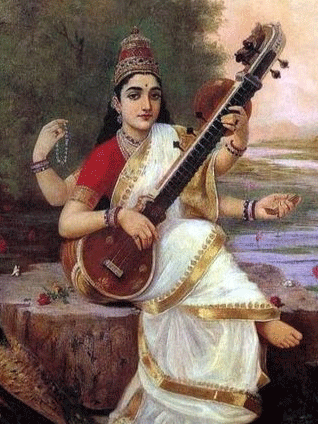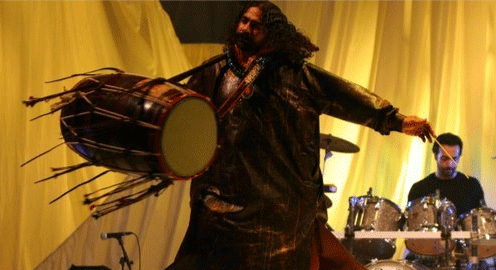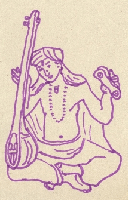Indian Music, different Manifestations
 The Genesis of Indian Music
The Genesis of Indian Music
The origin of Indian music dates back to Vedic period. Vedas,the most sacred and the oldest scriptures of Hindus and Hinduism mention that there existed a practice of singing hymns from Sama Veda, another sacred book of Hinduism. It means the Hymns were sung, not chanted. Even in Puranic age, Giddess Saraswati is described as the Goddess of education and all arts.Any musician or any scholar who is considered as an erudite in his/ her field is described as "Saraswati Putra" or the beloved son of goddess Saraswati, who herself is known as Veena Pani, means holding the Veena in her hand.
The purpose of Music :
That the Music soothes the senses is a well known fact. Music has a great importance in religion especially Hinduism. Observe a devotee who sings in ecstasy to praise the God. We are not new to the experience of seeing people slipping into a trance evn while singing normally. That's the powewr of music. Seeing its immense power of this medium of expression that's capable of conversing with the god, in any form, be it an open throated vocal or a spirited playing of Veena, Sastras accepted Music as an integral part of religion.
In Hindu mythology one will see many gods and goddesses are associated with some musical instrument or the other. Krishna and the flute in his hand are a classic examples. Brahma playing cymbals, Narada singing the virtues of the god with his ever present Tanpra are but a few examples of music's role in mythologies.
The Indian classical music can be divided in to two major categories. They are
Hindustani classical music
Carnatic Music.
Hindustani classical music is mainly practised in the Northern part of Inda, Pakistan and Bangla deah. Carnatic music is practised in the four southrn states of India, Andhra Pradesh, Karnataka, Kerala and Tammil nadu.
 Different faces of Hindustani Classical Music.
Different faces of Hindustani Classical Music.
The major vocal forms of Hindustani classical music are
- Dhrupad
- Khyal
- Tarana
The musical instruments that generally follow Dhrupd are,Tambura. Pakhawaz and Rudraveenaa, an ancient stringed instrument. Pakhwaz is a percussion instrument. A Dhrupad's theme is primarily devotional. They are about the praisings of a deity. The gtreat singer Tansen widely known as Mian Tansen is a well known Dhrupad singer. The lighter form of Dhrupad is known as Dhamar. During the festivities og Holi, the clours festival Dhamar is sung.
Though Dhrupad is the main form of Northern Indian Cassical music, gradually, over a period of time, it gave way to Khyal. Khyal is a more free form style of singing. With Dhrpad's exit from the Numero - Uno position, it has gone down sliding to the stage of extinction. Dagar brothers, strived and succeeded in reviving the lost glory of Dhrupad.
Well known Dhrupad experts include Dagar brothers, Gundecha brothers, Mallik family of Darbhanga tradition. Ram chatur Mallik, Siyarsam tiwari and Vidur mallik.
Khyal is said to be created by Amir Khusrau, a musician and a scholar.
Tarana, another form of vocal music which is usually sung to celerate a victory or some other moment of Joy.
Other Forms.
Tappa is a semi Indian classical vocal music
Thumri a romantic or devotional rendition usually sung by a girl to express the lovefor Krishna.
Ghazal is a poetic expression to express the pain generated due to separation.
Instrumental Music in Hindustani music is creted by the use of Sitar, Sarod, Sarangi etc.
Salient features of Carnatic music.
Vocal music is the mainstay of Carnatic music. The songs compsed are meant for singing. Its important components are Sruti ,Swara, Raga and Taala.
Sruti is referred as Key in Western music. Sruti in Carnatic music means Pitch.
Swara is the type of musical note In the octave Sa- re- ga- ma- pa-dha- ni.
Prominent composers of Hindustani music
Mia Tansen
One of the 9 gems at the court of Mughal emperor Akbar. His original name was Ramtanu Pandey. He was a born genius. His musical prowess was so amazing that Emperor gave him Honorific Miyan to Tansen. Since then Tansesn has become Mia Tansen, Mia is a word of respect and veneration. Generally conferred on People with erudition.A legend goes that Tansen was presented onr lakh gold coins on his very first performance. Owing to his immense and fabulous contribution to the music world, even today he has bcome an iconic figure to all the leading singers of the world,
Amir Kusrow
Also known as Amir Khusro Dehlavi (Amir Khusro of Delhi ). He is an Indian. A disciple of Nizamuddin Auliya of Delhi. An extraordinary personality with many faceted talents. He is believed to be the inventor of Qawwalii and the percussion instrument which we know as Tabla.
Bade Ghulam Ali Khan
!902-1968
Bade Ghulam Ali Khan is a Hindustani classical vocalist from Patiala Gharana. Strangely this vocalist of repute did not start his career as a singer, but as a Sarangi player to the female musicians and singers. Bade Ghulam Ali Khan won the coveted Sangit Natak Aademi award and Padma Bhushan in 1962. Khan died in Hyderabad in the year 1968 after a prolonged illness.
Prominent composers of Carnatic music
Purandara Dasa
Considered as the Pitamaha of Carnatic music, Purandara Dasa lived between 1484 and 1564. He was also known as Naradaavatari, the incarnation of sage Narada who is well known for his high calibre in music in mythologies. Purandara Dasa who has created compositions in Kannada and Sanskrit dealt with social problems along with Bhakti (Devotion) . This was a unique practice in those days.
The teaching methods of carnatic music to students was put in an orderly way and in a systematic way by Purandara Dasa, that is" how to start te rudiments and gradually take the student to the higher levels effortlessly to enable the student assimilate the subject in the best possible way" was devised and designed by Purandara Dasa. And the system is being followed even today.
Why he was hailed as "Sangeeta Pitamaha."
Purandara Dasa was a Vaggeyakara means he writes, and composes. Purandara Dasa was Lakshanakara, means, he is a musicologist. Its due to his multifaceted and alround knowledge, Carnatic music hailed him as Sangeeta Pitamaha. Purandara Dasa is the most revered person in the field of Carnatic music.
Another uniqueness in Purandara Dasa was that his influence on Hindustani music is amazig. We know that Tansen is the Doyen of Hindustani Music, And we know Tansen's teacher Swami Haridas was Purandara Dasa. The fact that Purandara Dasa's compositions were equally famous in Hindustani Music, speaks volumes about Purandara Dasa's versatality.
Presently rendering Purandara Dasa's compositions and Dasa Sahitya songs has become the order of the day. Tirumala Tirupati Devasthanam also propagating this great Man Purandara Dasa's compositions in the best possible way.
Tyagaraja
The trinity of Carnatic Music
Tyagaraja along with Muthuswami Dikshitar and Syama Sastry are well known as the Trinity of Carnatic music. Tyagaraja was the most prolific Carnatic music composer and most of his compositions are on Rama.
Annamacharya
Tallapaka Annamacharya, also popular as Padakavita Pitamaha or the grand old man of song writing in Telugu language has 36000 keertanas or the praising songs of Venkateswara. in Telugu. He is believed to be the reincarnation Vishnu's sword, Nandakam. Annmacharya's wife Thimmakka is the first female poet in Telugu literature.
Like it on Facebook, Tweet it or share this article on other bookmarking websites.


